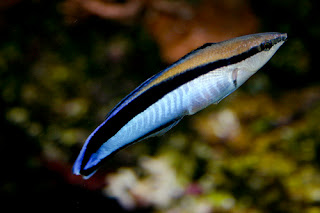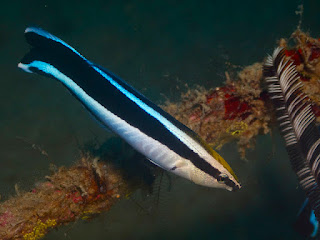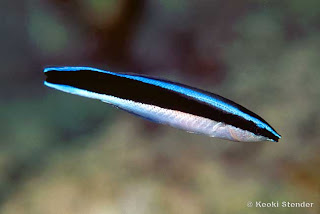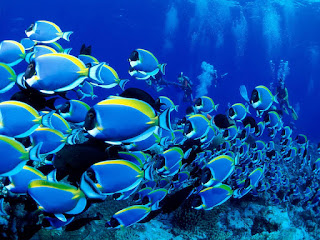Showing posts with label fish. Show all posts
Showing posts with label fish. Show all posts
Sunday, July 29, 2012
Bluestreak Cleaner Wrasse
The Bluestreak Cleaner Wrasse is part of the cleaner wrasse family, which is often found roving around the Pacific Ocean, the Indian Ocean and in various seas in Southeast Asia and the Red Sea.
Oscar, the title character of the 2004 Dreamworks-produced Shark Tale, was actually a Bluestreak Cleaner Wrasse, whose “cleaning duty” premise can be described as a tailor-fit plot device for the animated feature. Though the movie didn’t exactly rake in critical acclaim, it was a commercial success, and with its success, interests directed towards the Bluestreak Cleaner Wrasse was increased.
As with other types of cleaner wrasse, the Bluestreak Cleaner Wrasse is known for is mutualist relationship with larger fish species, with its small size and opted diet of dead tissues and parasites. Also known to physically sport a blue streak lining along its entire body, the Bluestreak Cleaner Wrasse’s name can be pegged as a literal definition of the fish as a species.
Most of the Bluestreak Cleaner Wrasse’s “clients” identify them through their body’s blue streak, and once they are recognized, the Bluestreak Cleaner Wrasse gets busy by cleaning up the large fish’s body from unwanted on-surface build ups, mostly focusing on areas which aren’t easy to “reach”.
The gills of large fish, for example, are common areas which Bluestreak Cleaner Wrasses would first clean, as well as the mouth of large fishes, where bits of tissue can easily get stuck.
What the Bluestreak Cleaner Wrasse gets from the setup is protection from underwater predators, as well as their daily diet of parasites and bits of dead tissue.
As a species, the Bluestreak Cleaner Wrasse is an interesting one, given how it naturally thrives with larger predators swimming around its natural habitats.
Growing as large as four inches in size, they are quite small and easy prey for larger fish, but their smallness hasn’t been an issue for them, in finding a way for them to live without any danger underwater.
Sunday, July 1, 2012
Blue Tang Fish
Blue Tang fishes may not be the most easily recognizable fish types, but as the Clown Fish took the center stage in the 2003 Disney hit Finding Nemo, the Blue Tang fish was actually a fish type highlight in the film.
In fact, it played a pivotal supporting role in the feature – that of Dory, Marlin’s compatriot in his search for Nemo.
As fish species, Blue Tang fishes are typically found in tropical waters, as with most of the undersea creatures highlighted in the film. Active in the Indo-Pacific regions, Blue Tangs can be typically found in coral reefs, feeding on zooplankton for their day to day dietary needs.
Though no link between Dory’s memory problems and the Blue Tang’s inability to remember things is known to be, the Blue Tang fish does have one unique trait which has made them unique among fish species – they only turn blue when they reach maturity.
A Blue Tang, upon hatching, isn’t hatched blue, but rather hatched with a silvery-grey hue. As they mature and grow into adulthood, their colors change, eventually morphing into shades of blue.
Blue Tangs are among the most at-risk fish species in tropical waters due to the destruction of coral reefs, the natural habitat for a number of tropical underwater creatures.
As a feature, Finding Nemo may have had parental love being the core value of its plot, but as an environmental awareness campaign, Finding Nemo has done well in spreading the word about the importance of keeping the Earth’s underwater ecosystem in check.
However one puts it, pollution is still a threat to all creatures of the Earth, and as its dominant species, we owe it to our fellow Earthlings to take good care of our natural resources and ecosystem.
Thursday, June 21, 2012
Wednesday, June 6, 2012
Piranha
Piranha II: The Spawning is one movie that is quite special and unique, not so much because of the generally “deadpan” script and cinematic factors of the movie, but more because it was actually directed by James Cameron of The Terminator and Avatar fame.
Though Cameron did eventually get to direct and pen down better movies after, the film, as a creature-feature, showcased mutated piranhas which gained the ability to fly through “fin flapping”, which generally caused a lot of problems in and out of the water for the movie’s cast characters.
Given the “rabid” attribute associated with piranhas, one has to ask: can piranhas actually do what they did in Piranha II: The Spawning?
No, they can’t.
In fact, piranhas have been victims of unreservedly being pegged as rabid fishes, as mindless bodies of teeth with eating out anything being their only priority.
Piranhas are actually kept by many as pets, housed in aquariums in different households where keeping them as pets is legal. As pet fishes though, they are not like your average goldfish, and their care and keep also has a degree of danger and risk involved.
As fish types, there are different piranha species and as a species they are classified as omnivores, since there are certain piranhas which only eat plants. Bet you didn’t know about that.
Also, as pet fishes, piranhas tend to grow to large sizes, with some measuring as big as two feet. Large tanks/aquariums are really necessary if one intends or keeps a piranha. Also, piranhas are generally kept in small numbers, at times even as solitary fishes. This is because there are cases of piranhas attacking their fellows in same-shared tanks.
But with its particular upkeeps and care aside, piranhas are interesting pet fish to have, though care in their handling has to be constantly maintained, ensuring that no harm comes to piranhas and pet owners, alike.
Piranha Pictures
Piranha Picture
Piranha image
Piranha Wallpaper
Piranha Wallpaper
Piranha Wallpaper
Piranha Wallpaper
Piranha Wallpaper
Piranha Video
Saturday, June 2, 2012
Clown Fish
Clownfish fascinations went double with the release of Disney/Pixar’s Finding Nemo, in 2003, telling the tale of how an overly protective clownfish father risked his life in rescuing his “kidnapped” son.
An inspiring story giving emphasis over what parents would do and risk just to be their for their young, Finding Nemo was a huge hit, not just for Disney/Pixar, but also for clown fishes all over the world.
Dispelling certain traits which are associated with clownfish – like how Marlin, Nemo’s dad, turn out to be a clownfish with a bland sense of humor – the movie shares a lot about natural clown fish traits, like their unique relationship with sea anemones.
Of course, that is not all there is to tell about clownfishes. Here are some more clownfish facts:
Generally, clownfish are part of a group/type of fish known as damselfish. They are inshore reef dwellers, and are typically found in tropical waters. Mother clownfish are known to lay eggs near anemones, which are often located on the base of corral reefs.
When it comes to overprotective fathers, clownfish have that role perfected, given the fact that a male clownfish would guard eggs spawned in batches until they hatch. Some male clownfish species are even known to take active care of their young, which pretty much says a lot about Marlin and his relationship with Nemo.
In terms of their diet, clownfish work with sea anemones, given that they are immune to the stings of an anemone’s tentacles. Given their vibrant colors, hence the source of their name, they would swim around in an arc close to where a sea anemone is, luring predators close to them.
Once a predator is drawn to them, they’d simply swim back towards the sea anemone, which would then do the deed of capturing prey for clownfish.
As a fish variety, they are protected by most governments, given that they play a vital role in the natural symbiotic balance of marine corral reef life.
Basically, this means that having clownfish in aquariums is not as easy as what the dentist in Finding Nemo did.
But still, after seeing the movie, would you still want to take a baby clownfish from his dad?
Clown Fish Pictures
Clown Fish image
Clown Fish Picture
Clown Fish images
Clown Fish Wallpapers
Clown Fish Wallpaper
Clown Fish Wallpaper
Clown Fish Wallpaper
Clown Fish Video
Labels:
Clown Fish,
Clown Fish Pets,
Finding Nemo,
fish,
Fish Pets,
nemo,
pet,
pets
Friday, June 1, 2012
Big Fish
Big fish are quite big hits, not just when talking about them in fishing circles or when talking about the movie, but also when referring to them as prized pets, often kept for their unique and impressive sizes and bulks.
The 2003 film bearing the Big Fish title was not exactly about a big fish, but rather takes its title from an age-long pun or adage (however you call it) where fishers of the old days would tell tales of them catching the biggest fish ever to be.
With the tall-tales and stories from the movie’s main character, the film managed to capture audiences into wondering once more, to see and believe in the power of big fish tales.
However, when talking about real big fish, pet owners with real big fishes don’t really have a difficult time in believing in a big fish’s actual existence.
The alligator gar would be one popular big fish pet, often prized because of their massive size and their generally “tough as nails” features.
A member of the gar species of fishes, alligator gars are often found in the freshwaters of North America, capable of growing up to 10 feet in length. They are different from other gars in the sense that their upper jaws come with rows of teeth, which had earned them the name “alligator gar” since their physical form bears some distinct alligator likeness.
Most alligator gars caught as trophies sport a silver-grey toned hue, but different colors and varieties are known to exist, some with orange-toned scales or with dark-deep-blue hue undertones. These are the varieties which are often found kept as exotic big fish pets.
Alligator gars are carnivorous, so for pet fish aficionados who aren’t keen on feeding live prey to pets, keeping an alligator gar may not be such a great idea. Also, given that alligator gars tend to grow into big sizes, their upkeep goes beyond feeding concerns, requiring occasional alterations with their enclosures.
But as big fish pets, they are big, and not only that, they’re quite mean lookers, an added plus for those on the lookout for exotic big fish pets.
Think the alligator gars’ the right big fish for you?
Monday, April 30, 2012
Arowanas in your Aquarium
Popularly dubbed as the “dragon fish”, the Arowana (also spelled as aruana or arawana) is one of the most popular types of big fishes kept by avid fish collectors, capable of growing as big as four feet long.
Known for being feisty and temperamental, Arowanas are part of the Osteoglossidae family of fishes, easily identified as “bony tongues”. With origins which date back to prominent species during the Jurassic Period, the Arowana’s head structure is bony, with its body elongated in shape, covered with large heavy scales.
As a member of the Osteoglossidae family, Arowanas are carnivores, as the floor of their mouths would reveal toothed bones (the “tongue”, so to speak). Arowanas are specialists for surface feeding, and owners, at one point and time, have revealed of instances when feeding them has left nicks on their fingers.
If keeping an Arowana is on your list of future plans, know that they are quite puckish when it comes to their diets, opting for live food over non-live varieties. Generally, they do not eat anything that is at the bottom of tanks, but they can adjust to food items which easily float on water surfaces.
They are known to go for insects such as grasshoppers, locusts, and crickets, and also respond well with worms. Small frogs are also a “treat” for Arowanas, along with certain species of smaller shrimp. Small fish is a popular type of “feed” opted by Arowana owners, but going for small fish as Arowana meal staples isn’t highly advised.
With different types of Arowanas, primarily defined by their color, the most commonly encountered type would be the Silver and Red, with known varieties of Gold among the ranks.
Though they are naturally temperamental, Arowanas do get to cool and calm down over time, which would make things easier for you if you do plan on getting one.
Just keep in mind that though they are beautiful to behold, their upkeep – primarily with what they eat – calls for a degree of commitment in keeping them in your aquarium.
Known for being feisty and temperamental, Arowanas are part of the Osteoglossidae family of fishes, easily identified as “bony tongues”. With origins which date back to prominent species during the Jurassic Period, the Arowana’s head structure is bony, with its body elongated in shape, covered with large heavy scales.
As a member of the Osteoglossidae family, Arowanas are carnivores, as the floor of their mouths would reveal toothed bones (the “tongue”, so to speak). Arowanas are specialists for surface feeding, and owners, at one point and time, have revealed of instances when feeding them has left nicks on their fingers.
If keeping an Arowana is on your list of future plans, know that they are quite puckish when it comes to their diets, opting for live food over non-live varieties. Generally, they do not eat anything that is at the bottom of tanks, but they can adjust to food items which easily float on water surfaces.
They are known to go for insects such as grasshoppers, locusts, and crickets, and also respond well with worms. Small frogs are also a “treat” for Arowanas, along with certain species of smaller shrimp. Small fish is a popular type of “feed” opted by Arowana owners, but going for small fish as Arowana meal staples isn’t highly advised.
With different types of Arowanas, primarily defined by their color, the most commonly encountered type would be the Silver and Red, with known varieties of Gold among the ranks.
Though they are naturally temperamental, Arowanas do get to cool and calm down over time, which would make things easier for you if you do plan on getting one.
Just keep in mind that though they are beautiful to behold, their upkeep – primarily with what they eat – calls for a degree of commitment in keeping them in your aquarium.
Arowanas Pictures
Arowanas image
Arowanas Picture
Arowanas images
Arowanas picture
Arowanas picture
Arowanas Wallpaper
Arowanas Wallpaper
Arowanas Wallpaper
Arowanas Video
Subscribe to:
Comments (Atom)




















































